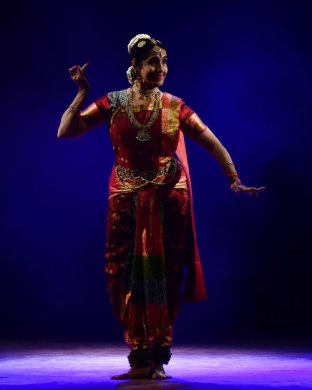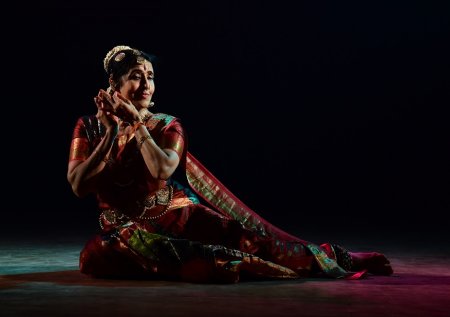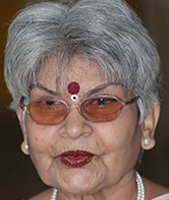
|   |

|   |
Padmavati - An Avatar - Manjari Sinha e-mail: manjari@sinha.com January 26, 2023 The 12th-century Sanskrit poet Jayadeva and his magnum opus Geeta Govind, the song of the divine love between Radha and Krishna, have been a perennial source of inspiration for painters, musicians, and dancers alike. The 'ashtapadis' of Geeta Govind are sung in various styles of music from Hindustani classical to Carnatic, Odissi, and Sopanam style of music of Kerala. These ashtapadis have also been an integral part of abhinaya in almost all the classical Indian dance forms. It was perhaps for the first time, that someone thought about Padmavati, the temple dancer of Jagannathpuri, who inspired Jayadeva himself. Bala Devi Chandrashekar, the New Jersey based Bharatanatyam exponent, research scholar, and a passionate, committed teacher, did extensive research in this unexplored area, consulted Sanskrit scholars and created 'Padmavati - An Avatar,' a thematic operative presentation on Padmavati, the cynosure of the immortal classic Geeta Govind.  Conceived, choreographed, and performed solo by Bala Devi Chandrashekar 'Padmavati - An Avatar' was presented by Guru Gajendra Panda, Director Tridhara, at Utkal Rangamanch, Guru Kelucharan Mohapatra Odissi Research Centre, Bhubaneswar. Tridhara also bestowed upon her their 'Nritya Ratna Award' earlier that evening. Sringara rasa, the sensual thread of the love poem Geeta Govind was imaginatively woven around Padmavati and Jayadeva, the temple dancer and poet couple, juxtaposed with the amorous intimacy between Radha and Krishna. The opera like ekaharya abhinaya, where just one dancer enacted different characters, situations, and emotions, left the audience spellbound. Jayadeva and his Geeta Govind are the favourite of artistes and audiences alike in Odisha, but watching it in Bharatanatyam was something else for the Odia rasikas, who lined up to congratulate Bala Devi at the end of her scintillating performance. The music enhancing the captivating choreography was thoughtfully composed by Rajkumar Bharathi which created most appropriate ambiance for each and every scene, from the very beginning. The joyous abandonment of raga Harikambodhi, for instance, was ideally suited for the auspicious opening scene of Padmavati and Jayadeva's wedding and the verse "Dehi pada pallavamudaram..." during the Saptapadi ritual when Jayadeva is reminded of this verse as if Krishna asking Radha to place her foot on his head to remove the sufferings of the 'Virahataap' (separation from the beloved). Likewise, their Grihasthashrama which revolved around indulging in dance and music was brought out remarkably well in sollukattu and swaras in ragam Kapi and adi talam, danced flawlessly by Bala Devi. The whole dance-drama was woven into four acts depicting the four stages of Bhakti (devotion) - Saalokyam - being in his world, Saarupyam - taking his form, Saamipyam - approaching him and finally Saayujyam - becoming one with the beloved. The whole philosophy of divine Bhakti was thus brought out through stories in these four segments. Depicted in the first act, for example, is the rustic simplicity of the flower vendor and her devotion, in singing the songs of Geeta Govind, while making garlands for lord Jagannath who puts his ring in her flower basket as a blessing. The flower vendor is accused of stealing the ring and getting released when the Lord appears in the king's dream and explains how the ring reached her flower basket. The Geeta Govindam based on Brahma Vaivarta Purana, is a Suddha-Prabandha, Nritya-Geya-Kavya of twelve sargas bearing the Dwadashakshari Mantra (twelve syllable mantra) of lord Krishna comprising of twenty four ashtapadis. The sublime sentiment of devotion is treated through love or Madhurya Prema bhava through Nayaka-Nayaki bhava as Sringara Maha Kavya. The agony of separation from a lover is predominantly depicted by Padmavati through three major characters, Lord Krishna, Radha, and a Sakhi who is intellectually perceived as a Guru. The theology that Gopis in their former life were the Nityasiddhas, Devakanyas, and Maha-Upanishadvakyas, are reinforced from the first act only. They assumed the form of the gopis to be one with Samodhadamodaraha. One of the Upanishad-Vakyas is brought out as a rhythm piece in adi talam and Bageshri ragam "Rupam rupam pratirupo babhuva, roopam roopam prathirupo bahischa" that means, "In every form he appears in a corresponding form", perceived as Radha and Gopi as the inner conscience. The first seven ashtapadis clearly portray the earnest desire of the Gopis to attain the supreme abode, the Saalokyam. This theme closely follows 'Rasakreeda' mentioned in Srimad Bhagavata Mahapurana referred to as Raasapanchaadhyayi. Poet-scholar Melpathur Narayana Bhattatiri's work Sriman Narayaneeyam is known as Raasapanchadashaki. This act also has a reference from 'Nritya Lakshana Samhita', a dance treatise, interpreted for dance gestures, abhinaya, and mudras by K. Vasudeva Sastry. The scene opens with the clouds gathering over the sky, the forest dark in the shade of the Tamala trees; the night has advanced, and the child Krishna is frightened. "Oh Radha! Take him home", acting on the advice of Nandagopa, Radha and Madhava leave, on the way transforming as her beloved and engaging in love sport among the lonely bushes on the banks of the Yamuna. Here, poet Jayadeva and Padmavati offer their salutations to the Lord's ten incarnations set in ragam Gamanashrama.  The pleasant spring season, set in ragam Akila and misra chapu talam, is a prelude to the love sports of Radha and Krishna. The suffering of Radha becomes acute, when her friend recounts to her about a beautiful Gopi avidly drinking with her eyes the beautiful lotus face of Madhusudana. The Tala Prastharam for the Raasa Mandala is layered in tisram, chatusram, and khandam, followed by a Beejam by Leelasuka in his Krishna Karnamrutham, set in ragam Bageshri showcasing Madhava situated between each pair of gopis, and a gopi is situated between each pair. Sri Krishna, the son of Devaki, also appeared in the middle of the circle, playing his flute and singing. Akleshakeshava surrounded by other gopikas, Radha's anger towards him becomes more intense as she recounts to her Sakhi how she stood with bashfulness during their first encounter. The 'Snigdha-Madhusudana' in Bhairavi, for "Sa virahe tava deena…" to Chatur Chaturbhujah in "Priye charusheele", culminates with 'Saananda Govinda' for Saayujyam. Poet Jayadeva pours out Krishna's emotions in his beautiful poetry set to Vijaynagari ragam and misra chapu talam, where he suffers due to his boundless love for Radha. Krishna acknowledges his mistake in ignoring the lovelorn Radha and reaches the shore of the Yamuna and lies down oppressed with grief. The whole of Geeta Govinda goes through the four stages of Bhakti, Salokytam, Sarupyam, and Samipyam reaching the climax in Sayujyam or becoming one ultimately and the Supreetha Peethambara experiences fulfillment, aptly depicted with the abundance of the thillana in Nalinakanthi. 'Padmavati - An Avatar' culminates with the grandeur of the divine journey depicted at the Ratha Yatra of Puri Jagannath temple with cultural convergence, a multitude of festivities, in the fervor of devotional songs, drums, tambourines, and trumpets. Padmavati and Jayadeva, the soulmates, sing and dance in transcendence to the poetry of Geeta Govindam along with the deluge of devotees. The credits for the concept, research, and choreography of this production go to Bala Devi Chandrashekar, compilation of songs by Kovai Janakirama Bhagavathar and N Neela Bala Sharma, lyrics by Dr. S Umapathi Shiromani and music by Rajkumar Bharathi, who had the competent support of expert musicians for jathis and mridangam - Guru Bharadwaj, vocals - Srikanth Gopalakrishnan, Keerthana Vaidyanathan, Deepika Varadarajan, tabla and pakhawaj - Ganapathi, veena - Bhavani Prasad, violin - Embar Kannan, flute - Vishnu, shehnai - Ballesh, sitar - Kishore Kumar, chorus - Manoj Krishna and troupe. In the Bhubaneswar show, the anchoring was only in Odia. One wished there was also English or Hindi commentary alongside for the convenience of those who were not conversant with the language. The host organization Tridhara concluded the evening with two Odissi group choreographies of Guru Gajendra Panda by young students of Tridhara, which should have been ideally presented before the main Bharatanatyam production.  Manjari Sinha has an M.A. in Sanskrit and Music, and trained in vocal, tabla, sitar and Kathak dance. She has regular columns in national dailies as a music and dance critic. |